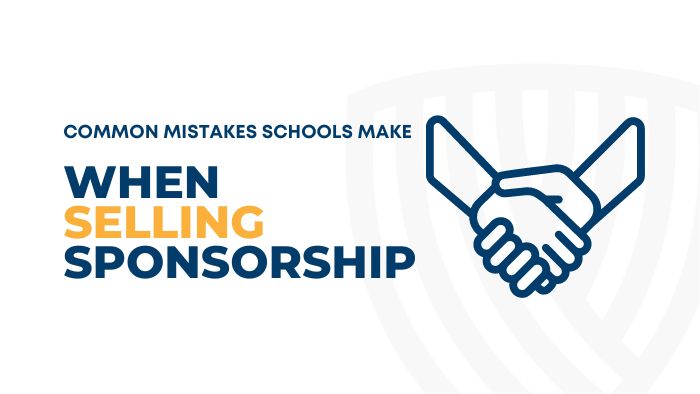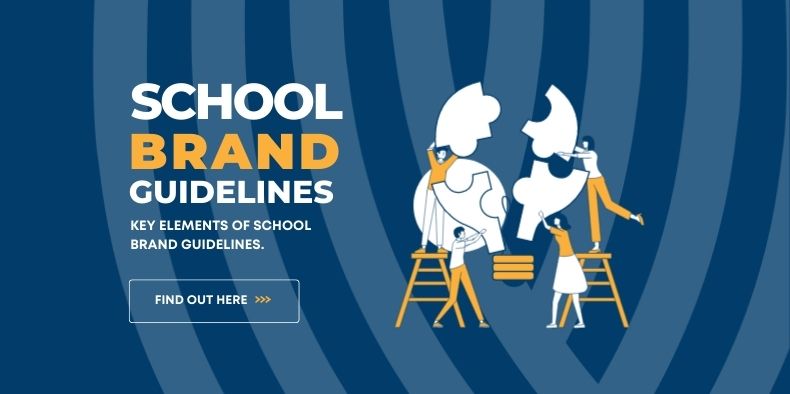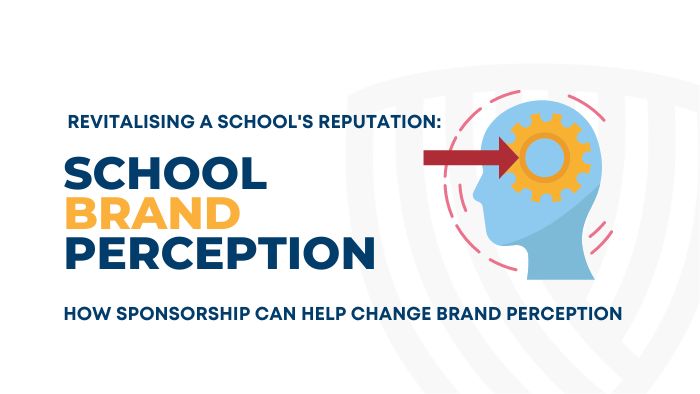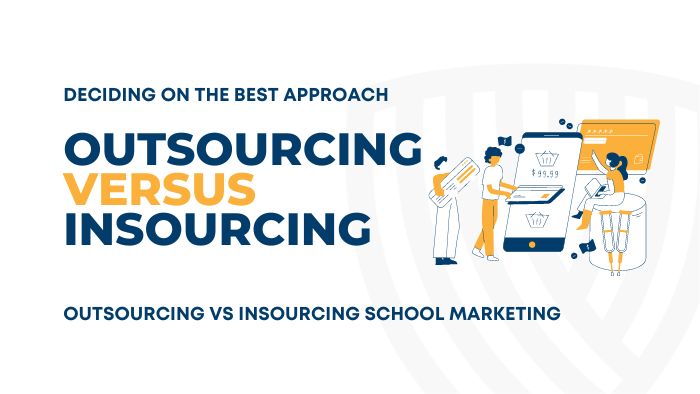
Common Mistakes Schools Make When Selling Sponsorship
By prioritising higher-tier sponsorships, streamlining communication with sponsors, targeting the right decision-makers, involving key school personnel, and handling sponsor inquiries tactfully, schools can significantly enhance their sponsorship sales strategies and unlock a world of opportunities for their students and institutions. Let’s explore these five crucial points to ensure a more effective approach in selling school sponsorships.
- Being tempted to sell lower-tier sponsorship packages first: It is recommended to sell higher-tier sponsorships first to establish credibility and build momentum. Holding back on selling lower tiers allows you to pitch them at the right time, in the right place, and in the right way.
- Taking too long to provide opportunity details after a meeting: Delays in sharing information can give sponsors the impression that execution may be an issue for the school. Promptly providing the necessary details avoids giving sponsors the chance to consider other opportunities.
- Not finding the name and contact details of decision-makers: Sending sponsorship information to generic email addresses like info@ or admin@ is ineffective. It is crucial to identify and contact the right person at a company who can make sponsorship decisions.
- Reach-outs for higher-tier sponsorships not coming from the school Principal: When pitching higher-tier sponsorships, it is essential for the conversation to be top-to-top, meaning it should involve the school Principal or someone in a high-ranking position.
- Not handling the “Yeah, send us your packages” reaction correctly: Sponsors often expect schools to provide sponsorship packages. However, if you are tailoring higher-tier sponsorships, there might not be a pre-set package to send. It is crucial to respond appropriately in such situations. If you need guidance on what to say or have encountered this situation, feel free to contact me.
By avoiding these common mistakes, schools can improve their sponsorship selling strategies and increase their chances of securing meaningful partnerships.

Key elements of a school brand style guide
A school brand style guide is a document that outlines the key elements of a school’s brand identity and provides guidelines for how these elements should be used across all communication channels. A well-designed brand style guide can help ensure that a school’s brand identity is consistently applied, which can lead to increased recognition and loyalty among students, parents, and the wider community. Here are some key elements of a school brand style guide:
- Logo Usage Guidelines
A school’s logo is one of the most recognisable elements of its brand identity. The brand style guide should provide clear guidelines on how the logo should be used, including minimum size requirements, colour variations, and placement on different types of media.
- Colour Palette
Colour is a powerful tool in brand identity, and the brand style guide should include a colour palette that reflects the school’s values and mission. The guide should outline which colours should be used for primary and secondary branding, as well as specific colours for use in specific situations, such as on social media or in print materials.
- Typography
Typography is another important aspect of a school’s brand identity. The brand style guide should provide guidelines on which fonts to use and how they should be used, including font sizes, weights, and styles. This ensures consistency in typography across all communication channels.
- Tone of Voice
The tone of voice used in communication is a key element of a school’s brand identity. The brand style guide should provide guidelines on how the school’s voice should be expressed, including the use of language, tone, and style. This ensures that all communication from the school is consistent and aligned with the school’s values and mission.
- Visual Style
The brand style guide should also provide guidelines on the visual style of the school’s communication materials, including imagery, graphics, and other visual elements. This ensures that all materials are visually consistent and aligned with the school’s brand identity.
- Application Guidelines
Finally, the brand style guide should provide guidelines on how the school’s brand identity should be applied across different types of media, including print materials, digital communication, and social media. This ensures that the school’s brand identity is consistently applied across all communication channels.
In conclusion, a school brand style guide is a crucial tool for ensuring that a school’s brand identity is consistently applied across all communication channels. The guide should include clear guidelines on logo usage, colour palette, typography, tone of voice, visual style, and application guidelines. By following these guidelines, schools can build a strong brand identity that leads to increased recognition and loyalty among students, parents, and the wider community.

The Benefits of Building Long-Term Relationships with School Sponsors
Securing sponsorships is an important part of funding for schools, but building long-term relationships with sponsors can bring even greater benefits. By establishing a lasting partnership, schools can benefit from ongoing support, enhanced brand recognition, and increased opportunities for collaboration. Here are some tips for building long-term relationships with school sponsors:
Clearly Define Expectations: One of the most important factors in building a long-term relationship with a sponsor is clearly defining expectations from the outset. This means establishing goals and objectives for the sponsorship and outlining how each party will contribute to achieving them. By doing so, both the school and sponsor can work together more effectively towards mutual success.
Communicate Regularly: Communication is key to building any successful relationship, and this is especially true for sponsorships. Schools should establish regular communication with sponsors to update them on the progress of the partnership, share success stories, and address any issues that may arise. This ensures that the partnership stays on track and allows for adjustments to be made as needed.
Offer Ongoing Value: In order to build a long-term relationship with a sponsor, it’s important to offer ongoing value beyond the initial sponsorship agreement. This may involve offering opportunities for continued visibility and exposure, sharing relevant research or data, or involving the sponsor in future events or programs. By demonstrating the ongoing value of the sponsorship, sponsors are more likely to remain committed to supporting the school over the long term.
Show Gratitude and Recognition: Building a strong relationship with a sponsor also requires showing gratitude and recognition for their support. This may involve acknowledging their contributions publicly, offering VIP access to events or programs, or providing regular updates on how their support has made an impact. By showing genuine appreciation for their investment, sponsors are more likely to feel valued and continue supporting the school.
Be Flexible and Adaptable: Finally, building a long-term relationship with a sponsor requires flexibility and adaptability. As circumstances change, sponsors may need to adjust their support or priorities, and schools must be willing to adapt to these changes. By remaining flexible and responsive, schools can build a strong foundation for a lasting partnership.
In conclusion, building long-term relationships with school sponsors requires a commitment to communication, ongoing value, and flexibility. By clearly defining expectations, offering ongoing value, showing gratitude and recognition, and remaining flexible and adaptable, schools can establish a strong sponsorship relationship that benefits both parties over the long term.

How to make the most of your school’s images for marketing and communication
Images are a powerful tool for marketing and communication, particularly for schools. High-quality images can establish an emotional connection with your audience, present your facilities, and showcase the unique features of your school. However, having a collection of images is insufficient. To make the most of your school’s images for marketing and communication, here are some tips:
Organise your images
The first step in maximising your school’s images is to organise them appropriately. This can be accomplished by creating folders for various image categories, such as events, facilities, and programs. You can also use tags or keywords to simplify the process of locating specific images.
Use high-quality images
High-quality images are critical for creating a positive impression and projecting a professional image for your school. Use a high-resolution camera and avoid using blurry or poorly lit images. Consider hiring a professional photographer to capture images of your school’s facilities and events.
Customise your images
Customising your images can help you develop a distinct and consistent brand identity. Use your school’s colours, fonts, and logos to create branded images that represent your school. You can also use photo editing tools to adjust the brightness, contrast, and colour balance of your images.
Use images strategically
When using images for marketing and communication, it’s crucial to use them strategically. Consider the purpose of each communication and select images that are relevant and compelling. For example, if you are promoting a school event, use images that showcase the activities and atmosphere of the event.
Use images across different channels
To maximise the reach of your images, use them across various communication channels. This includes your school’s website, social media, newsletters, and marketing materials. Ensure that the images are optimised for each platform and adhere to the platform’s guidelines for image size and format.
Track your results
Tracking your results can help you understand the effectiveness of your images and adjust your strategy accordingly. Use analytics tools to track the engagement and reach of your images across various channels. This can help you identify which images are most effective and which channels are generating the most engagement.
In conclusion, images are a potent tool for marketing and communication, especially for schools. By organising your images, using high-quality images, customising your images, using images strategically, using images across different channels, and tracking your results, you can maximise your school’s images and create a robust brand identity that resonates with your audience.

How to use your school’s brand guidelines to build brand recognition and loyalty
Brand guidelines are an essential tool for any school looking to build brand recognition and loyalty among its students, parents, and the wider community. A well-designed and consistent brand identity helps to create a sense of professionalism, builds trust and familiarity with the audience, and communicates the school’s values and mission. Here are some tips on how to use your school’s brand guidelines to build brand recognition and loyalty:
- Consistent Use of Visual Identity
Visual identity is one of the most important elements of a school’s brand. It includes the school logo, typography, colour palette, and imagery. A brand style guide provides guidelines on how these elements should be used consistently across all communication channels, including print and digital media. Consistent use of visual identity helps to create brand recognition and makes it easier for students, parents, and the wider community to identify the school.
- Consistent Use of Tone of Voice
The tone of voice is another essential element of a school’s brand. It includes the language and style of communication used in written and spoken communications. A brand style guide provides guidelines on how to use tone of voice consistently across all communication channels. Consistent use of tone of voice helps to build trust and familiarity with the audience and creates a sense of professionalism.
- Create Branded Collateral
Branded collateral includes items such as stationery, uniforms, and merchandise. A brand style guide provides guidelines on how to use the visual identity and tone of voice consistently across all branded collateral. Creating branded collateral helps to reinforce the school’s brand identity and builds loyalty among students, parents, and the wider community.
- Engage with the Community
Engaging with the community is an essential part of building brand recognition and loyalty. This includes communicating with students, parents, and the wider community through social media, email newsletters, and other communication channels. A brand style guide provides guidelines on how to use the visual identity and tone of voice consistently across all communication channels. Engaging with the community helps to build trust and familiarity with the audience and creates a sense of involvement and ownership.
- Consistent Branding Across all Departments
Consistent branding across all departments helps to create a cohesive brand identity for the school. This includes ensuring that all departments use the same visual identity and tone of voice in their communications. A brand style guide provides guidelines on how to use the visual identity and tone of voice consistently across all departments. Consistent branding across all departments helps to create a strong and recognisable brand identity and builds loyalty among students, parents, and the wider community.
In conclusion, a well-designed and consistent brand identity is essential for building brand recognition and loyalty among students, parents, and the wider community. A brand style guide provides guidelines on how to use the visual identity and tone of voice consistently across all communication channels, creating a sense of professionalism, trust, and familiarity. Creating branded collateral and engaging with the community are also essential parts of building brand recognition and loyalty. Consistent branding across all departments helps to create a cohesive brand identity for the school, building loyalty and trust among students, parents, and the wider community.

How to create an image bank for your school
In today’s digital age, having an image bank for your school is essential for effective communication with parents, students, and the wider community. An image bank is a collection of high-quality images that showcase your school’s facilities, programs, events, and other important aspects of your school’s brand identity. Here are some tips on how to create an image bank for your school:
- Define Your Brand Identity
Before you start creating your image bank, it’s important to define your school’s brand identity. This includes your school’s values, mission, and key messages. By having a clear understanding of your brand identity, you can ensure that the images you collect and use are consistent with your school’s identity.
- Plan Your Image Collection
Once you have defined your brand identity, it’s time to start planning your image collection. Think about the types of images you need to showcase your school, including images of your facilities, students, faculty, and events. Make a list of the types of images you need and start collecting them.
- Use High-Quality Images
To ensure that your image bank is effective, it’s important to use high-quality images. Invest in a good camera or hire a professional photographer to take photos of your school’s facilities and events. Use high-resolution images that are clear and free from noise or distortion.
- Organise Your Images
Organising your images is essential for easy access and effective use. Create a folder structure that makes sense to you and your team, and use descriptive file names that make it easy to identify the content of each image. You can also use image management software to help you organise and search your image bank.
- Share Your Images
Once you have created your image bank, it’s important to share it with your team members and stakeholders. Make sure everyone knows where to find the images and how to access them. You can also use your image bank to create branded materials such as brochures, newsletters, and social media posts.
In conclusion, creating an image bank for your school is an essential part of building a strong brand identity and communicating effectively with your stakeholders. By defining your brand identity, planning your image collection, using high-quality images, organising your images, and sharing your images with your team and stakeholders, you can create an effective image bank that showcases the best of your school.

Revitalising a School’s Reputation: How Sponsorship Can Help Change Brand Perception
Schools today face a competitive landscape where having a strong brand perception can mean the difference between attracting new students and securing funding or falling behind. However, it’s not always easy to change a school’s brand perception, especially if it’s been negative in the past. One effective way to change a school’s brand perception is through sponsorship.
Identify the school’s current brand perception
Before you can change a school’s brand perception, you need to understand what it currently is. This could include gathering feedback from parents, students, and staff, as well as looking at metrics such as enrolment numbers and funding. Once you have a clear understanding of the school’s current brand perception, you can begin to develop a plan to change it.
Identify key sponsors
Identify the key sponsors who align with the school’s mission and values and have the resources to make a significant impact. This can include local businesses, non-profit organisations, and philanthropists.
Develop a sponsorship document
The sponsorship document should clearly communicate how the sponsorship will align with the school’s mission and values and the benefits to the sponsor and the school. The proposal should also highlight the school’s achievements and successes, and how the sponsorship will contribute to changing the school’s brand perception.
Communicate the sponsorship and its impact
Once the sponsorship is secured, communicate the sponsorship and its impact to the school community and beyond. This could include a press release, social media posts, and an event to recognize the sponsor. This will help to demonstrate that the school’s brand perception is changing and that the school is being recognized for its achievements and successes.
Measure and evaluate the success of the branding strategy
To determine the success of the branding strategy, it’s important to measure and evaluate the impact it has on the school’s brand perception. Use metrics such as website traffic, social media engagement, enrolment numbers, and funding to track your progress and adjust as necessary.
In conclusion, changing a school’s brand perception is a critical task that can be achieved with the help of sponsorship. By following the steps outlined above, schools can effectively change their brand perception and attract new students, secure funding, and create a sustainable revenue stream. With the help of Sponsorship Ready’s 3-step framework, schools can deliver on a sponsor’s business, brand, and community engagement objectives while effectively conveying their purpose, vision, and values, and improving brand perception.
Sponsorship Ready’s leading and proven 3-step framework enables schools to successfully deliver on a sponsor’s business, brand, and community engagement objectives, while effectively conveying their school’s purpose, vision, and values as well improving brand perception.
Find out how your school can become Sponsorship Ready with a FREE 30-minute strategy session or email via info@sponsorshipready.com.au and start succeeding in sponsorship at your school today!
Did you know Sponsorship Ready also supports schools in professional development and capacity building in social media marketing?
Why not check out our Capacity Building & Professional Development program that’s tailored to your school and features free templates and platforms to create social media content that performs.
Find out more on Sponsorship Ready’s Social Media Masterclass for Schools on Wednesday 1 March 2023 hosted at Woodcrest State College.

Building Strong Communities Through School Sponsorship
School sponsorship is a powerful tool for building strong, sustainable communities. It enables schools to provide a range of programs and services that support the well-being and development of students, families, and the wider community. In this blog, we will explore the importance of school sponsorship, community engagement, and social media content planning in building a successful school sponsorship program.
School sponsorship is a collaborative relationship between a school and a sponsor, such as a business, organisation, or individual. The sponsor provides financial or in-kind support to the school in exchange for visibility and recognition. The school, in turn, uses the sponsorship to enhance its programs and services, and to engage the community in the education of its students.
One of the key benefits of school sponsorship is that it allows schools to provide programs and services that they might not otherwise be able to afford. For example, a school might use sponsorship funds to provide extracurricular activities, such as sports teams or music programs, that support student development and engagement.
Another key benefit of school sponsorship is that it helps to build strong, sustainable communities. By engaging community members and organisations in the education of its students, schools can foster a sense of shared responsibility for the well-being and development of the community. This can lead to increased civic engagement and a stronger, more supportive community.
To build a successful school sponsorship program, it is important to engage the community in the process. This can be done by creating opportunities for community members to provide input and feedback on the school’s plans and priorities. For example, a school might hold a community meeting or survey to gather input on what programs and services the community would like to see supported through sponsorship.
In addition to engaging the community, it is also important to develop a strong social media content plan to promote the school’s sponsorship program. Social media platforms, such as Facebook and Instagram, are powerful tools for building awareness and engagement around school sponsorship. By creating and sharing engaging, relevant content on these platforms, schools can reach a wider audience and build support for their sponsorship program.
For example, schools can use social media to share stories and photos of students and teachers participating in programs and activities that are supported by sponsorship. Schools can also use social media to share information about upcoming events and activities that are sponsored by the school. Additionally, schools can use social media to share news and updates about the progress of their sponsorship program, and to thank sponsors for their support.
One important consideration when planning your social media content is to ensure that it aligns with your overall brand messaging and values. For example, if your business is focused on promoting healthy living, your social media content should reflect this by highlighting the ways in which your sponsorship is helping to improve the health and fitness of students and teachers.
Another important consideration is to make sure that your social media content is visually appealing and engaging. This can be achieved by using high-quality images and videos, as well as creative hashtags and captions.
It’s also a good idea to involve students and teachers in your social media content, as they can help to personalize the sponsorship and make it more relatable to your audience. For example, you could feature photos or videos of students participating in activities or programs that your sponsorship has helped to support.
In addition to these tips, it’s important to be consistent and timely with your social media content, to keep your audience engaged and informed about your sponsorship. You could schedule regular posts or even create a dedicated hashtag for the sponsorship.
Overall, school sponsorship can be a great way for businesses to give back to their community and promote their brand.
By planning your social media content strategically, you can effectively communicate the impact of your sponsorship and engage your audience in a meaningful way.
In conclusion, school sponsorship is a powerful tool for building strong, sustainable communities. By engaging community members and organisations in the education of its students, and by developing a strong social media content plan, schools can build support for their sponsorship program and provide a range of programs and services that support the well-being and development of students, families, and the wider community.
Sponsorship Ready’s leading and proven 3-step framework enables schools to successfully deliver on a sponsor’s business, brand, and community engagement objectives, while effectively conveying their school’s purpose, vision, and values as well improving brand perception.
Find out how your school can become Sponsorship Ready with a FREE 30-minute strategy session or email via info@sponsorshipready.com.au and start succeeding in sponsorship at your school today!
Did you know Sponsorship Ready also supports schools in professional development and capacity building in social media marketing?
Why not check out our Capacity Building & Professional Development program that’s tailored to your school and features free templates and platforms to create social media content that performs.
Find out more on Sponsorship Ready’s Social Media Masterclass for Schools on Wednesday 1 March 2023 hosted at Woodcrest State College.

Deciding on the Best Approach: Outsourcing vs Insourcing School Marketing
When it comes to school marketing, schools have two main options: outsourcing or insourcing. Outsourcing refers to hiring an outside agency or consultant to handle marketing tasks, while insourcing refers to handling marketing tasks in-house, with a dedicated internal team. Each option has its own advantages and disadvantages, and the right choice will depend on the specific needs and resources of your school.
Advantages of Outsourcing:
Expertise: Outsourcing allows schools to tap into the expertise of professionals with skills and experience in marketing. This can be particularly beneficial for schools that lack in-house marketing expertise or resources.
Flexibility: Outsourcing allows schools to scale their marketing efforts up or down as needed, without having to commit to a full-time internal team. This can be useful for schools that have fluctuating marketing needs.
Cost-effective: Outsourcing can be more cost-effective than building an internal marketing team, particularly for schools that lack the budget for a full-time marketing staff.
Advantages of Insourcing:
Control: Insourcing allows schools to retain control over their marketing efforts and messaging. This can be particularly important for schools that have a strong brand identity or a specific message they want to communicate.
Consistency: Insourcing allows schools to maintain consistency in their marketing efforts over time, which can be beneficial for building a strong brand and reputation.
Customisation: Insourcing allows schools to tailor their marketing efforts to their specific needs and goals, rather than relying on a one-size-fits-all approach from an outside agency.
When considering outsourcing vs insourcing, schools should weigh the advantages and disadvantages of each option and consider their specific needs and resources. Outsourcing can be a good option for schools that lack in-house marketing expertise or resources, while insourcing can be beneficial for schools that want to retain control over their marketing efforts and maintain consistency over time.
In summary, while outsourcing and insourcing both have their pros and cons, the best option for a school would depend on its specific needs and resources. It’s important to consider the level of expertise, flexibility, cost-effectiveness, control, consistency, and customization that’s required, and weigh it out against the available resources.
Did you know Sponsorship Ready also supports schools in professional development and capacity building in social media marketing?
Why not check out our Capacity Building & Professional Development program that’s tailored to your school and features free templates and platforms to create social media content that performs.
Find out more on Sponsorship Ready’s Social Media Masterclass for Schools on Wednesday 1 March 2023 hosted at Woodcrest State College.

Ready to take your schools brand to the next level?
Having a clear and consistent brand image is essential for any organisation, including schools. It helps establish a strong identity, communicate values and mission, and create a sense of trust with students, staff, parents, and the wider community.
That’s where we come in. At Sponsorship Ready, we specialise in creating comprehensive brand guidelines for schools. Our team of experts will work with you to develop a roadmap for maintaining a consistent image and message across all communications and materials, both internally and externally.
Our process includes:
Assessment: We’ll take a deep dive into your school’s unique identity, mission, and values to understand what sets you apart.
Strategy: We’ll use the information gathered in our assessment to develop a tailored strategy for your school’s brand. This includes defining key elements like your visual identity, tone of voice, and messaging.
Implementation: Our team will create a set of guidelines that you can use to ensure all communications, from flyers to brochures, stay true to your brand.
Ready to take your schools brand to the next level?
Check out Sponsorship Ready’s new brand guidelines!
By working with us, you can trust that your school’s brand will be effectively communicated and consistently applied across all materials. Investing in a comprehensive brand guideline is a crucial step in promoting a consistent and unified image for your school and building trust with stakeholders.
Get in touch with us today via info@sponsorshipready.com.au to learn more about how we can help your school establish a strong and recognisable identity.
